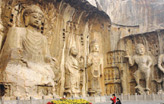Health
Small comfort for sufferers of textile contact dermatitis
Updated: 2011-03-23 07:40
By Eva Neumann (China Daily)
If the crooks of your arms are suddenly covered with itchy red pustules, a new sweater may be to blame. Many textiles contain numerous chemicals that, if not bound tightly in the fabric, can rub off on the skin and cause allergic reactions.
"Textile contact dermatitis is typically characterized by delayed reactions such as redness, scaling and eczema. The symptoms usually appear hours, sometimes even days, after contact with the material," notes Franziska Rueff, a dermatologist at the Ludwig Maximilian University of Munich.
The areas of the body most often affected are those having the most contact with clothing: the crooks of the arm, backs of the knees, armpits, groin area and buttocks.
"The reaction is intensified by the fabric rubbing against the skin and by sweating," says Silvia Pleschka, a chemist for the German Allergy and Asthma Federation. Eczema of this kind can generally be treated topically with just corticosteroid creams or ointments.
Immediate allergic reactions are less common. "They include wheals, redness, rash, respiratory and circulatory problems, and even anaphylactic shock," Rueff says.
Quick action is important if such symptoms appear. "The affected person should immediately remove the article of clothing, wash the skin thoroughly and take an anti-allergenic that is effective against hay fever or nettle rash," Rueff advises.
Textile contact dermatitis is more common in women than in men, Pleschka points out, because women wear close-fitting and colorful clothing more often.
"Among the groups at risk are allergy and neurodermatitis sufferers, and, of course, people with sensitive skin or a sensitive bronchial system that reacts to smells and perfumes by constricting the airways."
For everyone with textile contact dermatitis, the question is what substance triggered it. This is not easy to answer. "We can't manufacture any textiles nowadays without using chemical substances," remarks Heinrich Planck, director of the Institute of Textile Technology and Process Engineering in the southern German town of Denkendorf. Be it silk, cotton or polyester, the fibers have often been steeped in a veritable cocktail of dyes, textile resins and other substances.
"They lend beauty, color, shine, wrinkle resistance and wearing comfort," Planck says of the additives. Silver ions are also being used increasingly for their anti-microbial effect.
The chemicals contained in an article of clothing are apparent neither to customer nor salesperson. They are not listed on the label either, so a different avoidance strategy is necessary. People who have an immediate allergic reaction to a textile should promptly lay it aside.
They can also have a medical test that at least narrows down the group of chemicals that may have caused the reaction.
This, too, is of little help, however. "If a test shows someone to be allergic to a certain azo dye, for example, the person receives an allergy card stating same. But the card is of no use to the salesperson when the next article of clothing is purchased," Rueff says, because textiles are usually treated with a mixture of dyes whose individual components are not identified.
People who have sensitive skin or think they are allergic to a chemical found in textiles can avoid all textiles likely to contain a lot of chemicals. Clothing with labels such as "non-iron", "shape retention" or "dirt-repellent", for example, can be assumed to be chemically treated.
Textile dyes are frequently a problem. "Studies have shown that 49 of the approximately 800 textile dyes currently in use are potential contact allergens," Pleschka says.
Clothing marked "wash separately" is very risky since the manufacturer expects the dyes to bleed. Undyed fabrics or fabrics treated with natural dyes are an alternative. And light-colored clothing contains less dye than dark clothing. If it is also loose-fitting and has little contact with the skin, all the better.
German Press Agency
Specials

Tea-ing up
More turning to Chinese tea for investment opportunities like vintage wine

A cut above
The ancient city of Luoyang is home to a treasure trove of cultural wonders.

Rise and shine
The Chinese solar energy industry is heating up following recent setbacks in the nuclear sector